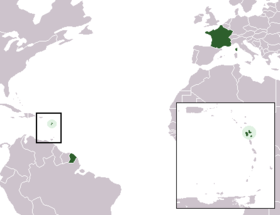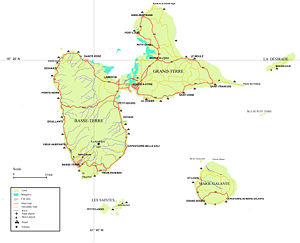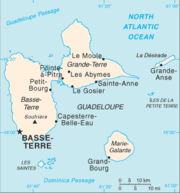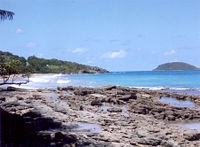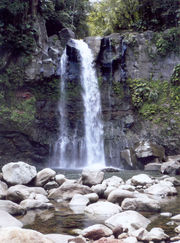Guadeloupe
2008/9 Schools Wikipedia Selection. Related subjects: Americas; Countries
| Région Guadeloupe | ||
|---|---|---|
|
 |
|
| Region flag | Region logo | |
| Location | ||
|
||
| Administration | ||
| Capital | Basse-Terre | |
| Regional President | Victorin Lurel ( PS) (since 2004) |
|
| Departments | Guadeloupe | |
| Arrondissements | 2 | |
| Cantons | 40 | |
| Communes | 32 | |
| Statistics | ||
| Land area1 | 1,628 km² | |
| Population | (Ranked 23rd) | |
| - January 1, 2007 est. | ca. 408,000 | |
| - March 8, 1999 census | 386,566 | |
| - Density (2007) | 251/km² | |
| 1 French Land Register data, which exclude lakes, ponds, and glaciers larger than 1 km² (0.386 sq. mi. or 247 acres) as well as the estuaries of rivers |
||
Guadeloupe is an island group or archipelago located in the eastern Caribbean Sea at , with a land area of 1,628 square kilometres (629 sq. mi). It is an overseas department of France. As with the other overseas departments, Guadeloupe is also one of the twenty-six regions of France (being an overseas region) and an integral part of the Republic. As part of France, Guadeloupe is part of the European Union; hence, as for most EU countries, its currency is the euro. Guadeloupe is however not party to the Schengen Agreement. The capital of Guadeloupe is Basse-Terre.
History
During his second trip to America, Christopher Columbus became the first European to land on Guadeloupe in November 1493, seeking fresh water. He called it Santa María de Guadalupe de Extremadura, after the image of the Virgin Mary venerated at the Spanish monastery of Villuercas, in Guadalupe, Extremadura. However, the expedition set ashore just south of Capesterre but did not leave any settlers ashore.
After successful settlement on the island of St Christophe (St Kitts), the French American Islands Company delegated Charles Lienard and Jean Duplessis, Lord of Ossonville to colonize one or any of the region’s islands, Guadeloupe, Martinique or Dominica. Due to Martinique’s inhospitable nature, the duo resolved to settle in Guadeloupe. The French took possession of the island in 1635 and wiped out many of the Carib Amerindians. It was annexed to the kingdom of France in 1674. Over the next century, the island was seized several times by the British. One indication of Guadeloupe's prosperity at this time is that in the Treaty of Paris (1763), France, defeated in war, agreed to abandon its territorial claims in Canada in return for British recognition of French control of Guadeloupe.
In 1790, the upper classes of Guadeloupe refused to obey the new laws of equal rights for the free colored and attempted to declare independence, resulting in great disturbances; a fire broke out in Pointe-à-Pitre and devastated a third of the town, and a struggle between the monarchists (who wanted independence) and the republicans (who were faithful to revolutionary France) ended in the victory of the monarchists, who declared independence in 1791, followed by the refusal to receive the new governor appointed by Paris in 1792. In 1793, a slave rebellion started, which made the upper classes turn to the British and ask them to occupy the island.
In an effort to take advantage of the chaos ensuing from the French Revolution, Britain attempted to seize Guadeloupe in 1794 and held it from April 21 to June 2. The French retook the island under the command of Victor Hugues, who succeeded in freeing the slaves. They revolted and turned on the slave-owners who controlled the sugar plantations, but when American interests were threatened, Napoleon sent a force to suppress the rebels and reinstitute slavery. Louis Delgrès and a group of revolutionary soldiers killed themselves on the slopes of the Matouba volcano when it became obvious that the invading troops would take control of the island. The occupation force killed approximately 10,000 Guadeloupeans in the process of restoring order to the island.
On February 4, 1810 the British once again seized the island. By the Anglo-Swedish alliance of March 3, 1813, it was ceded to Sweden but the British administration continued in place while Swedish commissioners were sent to make arrangements for the transfer. Sweden already had a colony in the area, but then by the Treaty of Paris of May 30, 1814, ceded Guadeloupe once more to France . An ensuing settlement between Sweden and the British gave rise to the Guadeloupe Fund. French control of Guadeloupe was finally acknowledged in the Treaty of Vienna in 1815. Slavery was abolished on the island in 1848 at the initiative of Victor Schoelcher. Today the population of Guadeloupe is mostly of African origin with an important European and Indian active population. Lebanese, Chinese, and people of many other origins are also present.
On February 22, 2007 the island communes of Saint-Martin and Saint-Barthélemy were officially detached from Guadeloupe and became two separate French overseas collectivities with their own local administration, henceforth separated from Guadeloupe. Their combined population was 35,930 and their combined land area was 74.2 km² at the 1999 census. Guadeloupe thereby lost 8.5 percent of its population and 4.36 percent of its land area, based upon numbers from that census.
Geography
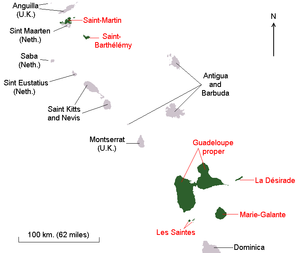
Guadeloupe comprises five islands: Basse-Terre Island, Grande-Terre (separated from Basse-Terre by a narrow sea channel called Salt River) with the adjacent islands of La Désirade, Les Saintes and Marie-Galante.
Basse-Terre has a rough volcanic relief while Grande-Terre features rolling hills and flat plains.
Further to the north, Saint-Barthélemy and the French part of Saint Martin once came under the jurisdiction of Guadeloupe but on December 7, 2003, both of these areas voted to become an overseas territorial collectivity, a decision which took effect on February 22, 2007.
Demographics
(July 2006 estimates from the CIA World Factbook; note that these estimates disagree with official INSEE estimates and that they also include Saint-Martin and Saint-Barthélemy)
| Population | 452,776 | ||
| Age structure | 0 to 14 years | 23.6% | male 54,725 female 52,348 |
| 15 to 64 years | 67.1% | male 150,934 female 153,094 |
|
| 65 years and older | 9.2% | male 17,353 female 24,322 |
|
| Population growth rate | 0.88% | ||
| Birth rate | 15.05 births | per 1,000 people | |
| Death rate | 6.09 deaths | ||
| Net migration rate | -0.15 migrants | ||
| Sex ratio (male:female) |
at birth | 1.05 | |
| under 15 years | |||
| 15 to 64 years | 0.99 | ||
| 65 years and older | 0.71 | ||
| Overall | 0.97 | ||
| Infant mortality rate | 8.41 deaths per 1,000 live births | ||
| Life expectancy at birth |
males | 74.91 years | |
| females | 81.37 years | ||
| Overall | 78.06 years | ||
| Total fertility rate | 1.9 children born per woman | ||
| Demonym | Guadeloupean(s) (not Guadeloupians) | ||
| Adjectival | Guadeloupe, Guadeloupean | ||
| Ethnic groups | Black / Mulatto | 69% | |
| White | 10% | ||
| from Tamil Nadu and other parts of India / Indian | 15% | ||
| Lebanese / Syrians | 4% | ||
| Chinese / others | 2% | ||
| Religion | Roman Catholic | 91% | |
| Protestant | 5% | ||
| Hindu / African | 4% | ||
| Jehovah's Witnesses | 2% | ||
| Language | French (official) 99%, Most locals also speak Creole language | ||
| Literacy | males | 90% | |
| females | |||
| Overall | |||
|
||||||||||||||
}}
Arrondissements, cantons, and communes
Guadeloupe is divided into arrondissements, cantons and communes:
- Arrondissements of the Guadeloupe department
- Cantons of the Guadeloupe department
- Communes of the Guadeloupe department
Major communities
- Baie-Mahault
- Le Gosier
- Le Moule
- Les Abymes
- Petit-Bourg
- Pointe-à-Pitre
- Sainte-Anne
Politics
Culture
Guadeloupe's culture is probably best known for the islanders' literary achievements, particularly the poetry of Saint-John Perse, the pseudonym used by Alexis Léger. Perse won the 1960 Nobel Prize in Literature "for the soaring flight and the evocative images of his poetry which in a visionary fashion reflects the conditions of our time."
Guadeloupe has always had a rich literary production prolonged today by many living writers, poets, novelists, essayists and journalists, among them Mesdames Maryse Condé and Simone Schwartz-Bart, M. Ernest Pépin.
Also culturally important are the arts, particularly painting and sculpture. Famous painters and/or sculptors include Michel Rovelas, Claudie Cancelier, Jean-Claude Echard, Christian Bracy, Roger Arekian, les Frères Baptiste, Michelle Chomereau-Lamothe, Léogane, Pédurand, Nicole Réache, Victor Sainsily. Guadeloupean visual effects artist compositor Karim Sahai of Weta Digital, New Zealand, has worked on the visual effects of many movies such as The Lord of the Rings, King Kong, and The Waterhorse.
Music and dance are also very popular, and the widely accepted interaction of African, French and Indian cultures has given birth to some original new forms specific to the archipelago. Islanders enjoy many local dance styles including the quadrille "au commandement", zouk, zouk-love, kompa toumbélé, as well as all the modern international dances. Typical Guadeloupean music includes la biguine and gwo ka à la base. Kassav' and Admiral T embody the traditional and the new generation of music. Many international festivals take place in Guadeloupe, like the Creole Blues Festival, the Marie-Galante Festival, Festival Gwo-Ka Cotellon, etc. It goes without saying that all the Euro-French forms of art are also omnipresent in the melting pot.
Another element of the Guadeloupean culture is its dress. Women in particular have a unique style of traditional dresses, with many layers of colourful fabrics, now only worn on special occasions. On festive occasions they also wore a madras (originally the 'kerchief' from South India) head scarf tied in many different symbolic forms. The headdress could be done in many styles with names like the "bat" style, or the "firefighter" style, as well as the "Guadeloupean woman." Jewelry, mainly of gold, is also important in the Guadeloupean lady's dress, a product of European, African and Indian inspiration. Many famous couturiers like Devaed and Mondelo are Guadeloupeans.
Football (soccer) is popular in Guadeloupe. Thierry Henry, a star of the French National Team and Spanish League club FC Barcelona, often visits, as his father Antoine was originally from the island. William Gallas, whose parentage is Guadeloupean, visits the island when not playing for Arsenal or the French National team. Lilian Thuram, a star football defender for France and FC Barcelona, was born in Guadeloupe. The French national team and Manchester United striker, Louis Saha, is also of Guadeloupean descent, as is MK Dons goalkeeper Willy Gueret. The region's football team experienced recent success, advancing all the way to the 2007 CONCACAF Gold Cup semi-finals, where they were defeated just 1-0 by CONCACAF powerhouse Mexico. Many fine track and field athletes, such as Marie-José Perec, Patricia Girard-Léno, and Christine Arron are also Guadeloupe natives. The NBA player Mickaël Piétrus was born in Les Abymes. Famed Bodybuilder Serge Nubret also hails from Guadeloupe.
Economy
In 2006 the GDP per capita of Guadeloupe at market exchange rates, not at PPP, was €17,338 (US$21,780).
The economy of Guadeloupe depends on tourism, agriculture, light industry and services. But it especially depends on France for large subsidies and imports.
Tourism is a key industry, with 83.3% of tourists visiting from metropolitan France, 10.8% coming from the rest of Europe, 3.4% coming from the United States, 1.5% coming from Canada, 0.4% coming from South America and 0.6% coming from the rest of the world. An increasingly large number of cruise ships visit the islands.
The traditional sugarcane crop is slowly being replaced by other crops, such as bananas (which now supply about 50% of export earnings), eggplant, guinnep, noni, sapotilla, paroka, pikinga, giraumon squash, yam, gourd, plantain, christophine, monbin, prunecafé, cocoa, jackfruit, pomegranate, and many varieties of flowers. Other vegetables and root crops are cultivated for local consumption, although Guadeloupe is still dependent on imported food, mainly from France.
Light industry features sugar and rum, solar energy, and many industrial productions. Most manufactured goods and fuel are imported. Unemployment is especially high among the youth. Hurricanes periodically devastate the economy.
The country code top-level domain (ccTLD) for Guadeloupe is " .gp".

